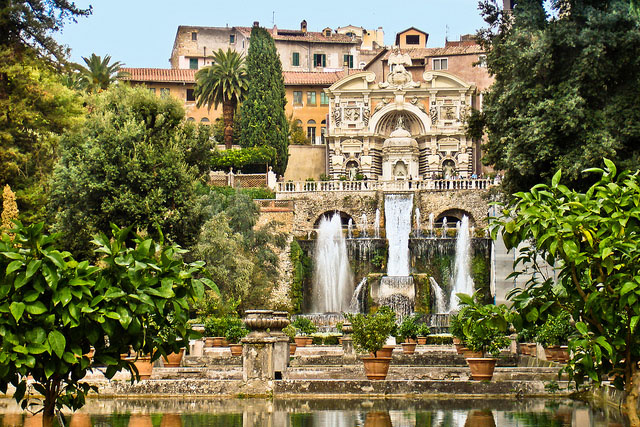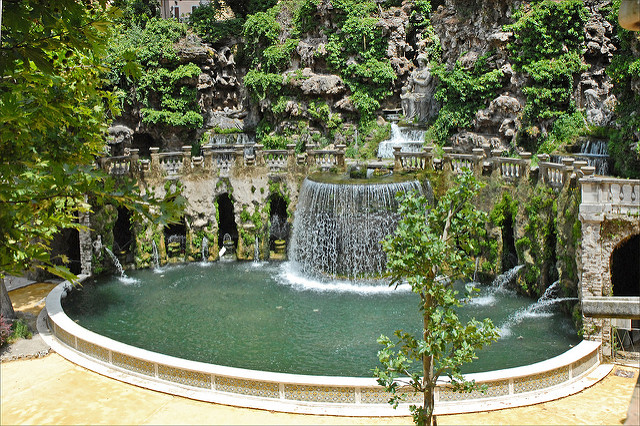Villa d’Este
 Este's Villa
Este's Villa

Un biglietto da visita che sorprende da subito per i numeri straordinari: una superficie di ben 35.000 mq trasformati dall’architetto Pirro Logorio in un giardino regale animato da 50 fontane, ben 255 cascate, 100 vasche e circa 150 piante secolari ad incorniciare vialetti romantici d’altri tempi.
It’s a pride to be seen that immediately surprises for its extraordinary characteristics: an area of 35,000 square meters which was transformed by the architect Pirro Logorio into a royal garden animated by 50 fountains, 255 cascades, 100 pools and about 150 ancient trees that frame romantic paths from another era.
Un tesoro dal valore inestimabile: una terrazza paradisiaca che, sopraelevata, regna incontrastata sulle pennellate bucoliche della pianura romana, dal dorato paglierino dei campi al verde brillante dei vigneti.
Villa d’Este is a priceless treasure: a heavenly terrace that reigns supreme from above, over the bucolic brushstrokes of the Roman plain, which ranges form the golden straw-like color of the fields to the bright green of the vineyards.
Dietro la sua costruzione c’è un’intricata storia: nel periodo rinascimentale i governanti, nella maggior parte dei casi molto colti, nutrivano una forte propensione artistica e culturale che sfociava spesso in costruzioni maestose, tutto volto all’esaltazione del concetto puro di Bellezza.
Behind its construction there is an intricate story: in the Renaissance period the rulers, who in most cases were very educated, had a strong artistic and cultural inclination that often led to majestic buildings, which were aimed at the exaltation of the pure concept of Beauty.

Anche per Villa d’Este le cose andarono così. Il progetto iniziale fu commissionato nella prima metà del 1500 dal governatore di Tivoli, Ippolito II d’Este, da cui ereditò il nome; ma fu solo a metà del 1800 che grazie all’intervento del cardinale Gustav Adolf von Hogenlohe Schillingsfurst la Villa tornò a splendere.
Villa d'Este was no exception. The initial project was commissioned in the first half of 1500s by the governor of Tivoli Ippolito II d'Este which it inherited the name from. The Villa rose again only in the mid-1800s thanks to the Cardinal Gustav Adolf von Hogenlohe Schillingsfurst’s intervention.
L’armonia finale deriva dalla perfetta fusione tra l’estetica e la genialità meccanica: le fontane zampillanti, simbolo allegorico di fecondità, lasciano sgorgare l’acqua del vicino fiume Aniene che, sfruttando la pressione naturale, fu fatta confluire in direzione della Villa attraverso lavori idraulici d’avanguardia per l’epoca. Al marmo vivente delle statue, alcune provenienti dalla vicina Villa Adriana, si accosta un altro fattore chiave: la continua sorpresa.
Its final harmony derives from the perfect fusion between aesthetics and mechanical genius: the gushing fountains, which are an allegorical symbol of fertility, spout out the water of the nearby river Aniene, which has been converged by exploiting its natural pressure in the direction of the Villa by means of avant-garde hydraulic work for those times. Besides the marble of the lifelike statues, some of which were brought there from the nearby Villa Adriana, another key factor is the continuous surprise.

L’intero percorso, passando per il viale delle Cento Fontane che ispirò persino alcuni versi di D’Annunzio, alterna dettagli imprevedibili che amplificano la magia di un luogo da tempo consacrato ad immortale.
The entire walk passes through the path of the Cento Fontane which inspired even some verses of D'Annunzio (famous Italian poet) and it reveals one after another unpredictable details that amplify the magic of a place that has been elevated to immortal for a considerable time.
Inevitabili le suggestioni: dall’arte contemporanea ai più famosi set cinematografici, la Villa avvolta nel suo principesco silenzio continua a far parlare di sé, custodendo antichi segreti e frammenti di storia.
Un rifugio incontaminato che resiste all’incalzare veloce del mondo.
Suggestiveness is inevitable: the Villa, surrounded by its regal silence, continues to be talked about through events that range from contemporary art to the most famous movie sets, while still preserving ancient secrets and fragments of history.
An unspoiled haven that resists the world fast pace.
Show sources
Fonti: http://www.romaweekend.com/suggestioninotturneavilladesteditivoli/ – http://www.italiauomoambiente.it/?p=4981 – http://www.tibursuperbum.it/ita/museo/index.htm – https://paroleinviaggioblog.wordpress.com/2015/01/07/villetivolivillaestefontane/ – http://www.italia.it/it/ideediviaggio/sitiunesco/villadesteiltrionfodelbarocco.html – http://www.meteoweb.eu/2016/01/allascopertadivilladesteuncapolavoroassolutodelDogiardinoallitaliana/624371/ - Immagini: M.Maselli. Tivoli (Rome), Villa d’Este. 16 ott 2008. Disponibile in: https://www.flickr.com/photos/mmaselli/5011244893/in/photostream/. Accesso in data 21 ott 2016. – JeanPierre Dalbéra. Fontana dell’Ovato (Tivoli). 9 giu 2011. Disponibile in: https://www.flickr.com/photos/dalbera/5869057358. Accesso in: 21 ott 2016.
More articles
See allLeave a comment!

No comments until now. Be the first to comment!